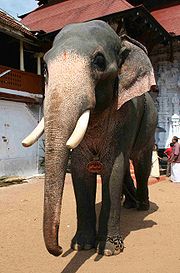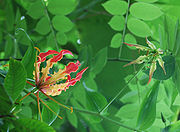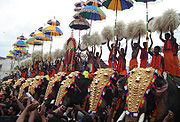Most of Kerala, whose native habitat consists of wet evergreen rainforests at lower elevations and highland deciduous and semi-evergreen forests in the east, is subject to a humid tropical climate. however, significant variations in terrain and elevation have resulted in a land whose biodiversity registers as among the world’s most significant.  Most of Kerala's significantly biodiverse tracts of wilderness lie in the evergreen forests of its easternmost districts; coastal Kerala (along with portions of the east) mostly lies under cultivation and is home to comparatively little wildlife. Despite this, Kerala contains 9,400 km2 of natural forests. Out of the approximately 7,500 km2 of non-plantation forest cover, there are wild regions of tropical wet evergreen and semi-evergreen forests (lower and middle elevations — 3,470 km2), tropical moist and dry deciduous forests (mid-elevations — 4,100 km2 and 100 km2, respectively), and montane subtropical and temperate (shola) forests (highest elevations — 100 km2). Such forests together cover 24% of Kerala's landmass. Kerala also hosts two of the world’s Ramsar Convention-listed wetlands: Lake Sasthamkotta and the Vembanad-Kol wetlands are noted as being wetlands of international importance. There are also numerous protected conservation areas, including 1455.4 km2 of the vast Nilgiri Biosphere Reserve. Most of Kerala's significantly biodiverse tracts of wilderness lie in the evergreen forests of its easternmost districts; coastal Kerala (along with portions of the east) mostly lies under cultivation and is home to comparatively little wildlife. Despite this, Kerala contains 9,400 km2 of natural forests. Out of the approximately 7,500 km2 of non-plantation forest cover, there are wild regions of tropical wet evergreen and semi-evergreen forests (lower and middle elevations — 3,470 km2), tropical moist and dry deciduous forests (mid-elevations — 4,100 km2 and 100 km2, respectively), and montane subtropical and temperate (shola) forests (highest elevations — 100 km2). Such forests together cover 24% of Kerala's landmass. Kerala also hosts two of the world’s Ramsar Convention-listed wetlands: Lake Sasthamkotta and the Vembanad-Kol wetlands are noted as being wetlands of international importance. There are also numerous protected conservation areas, including 1455.4 km2 of the vast Nilgiri Biosphere Reserve.
 Much of Kerala's notable biodiversity is concentrated and protected in the Agasthyamalai Biosphere Reserve in the eastern hills. Almost a fourth of India's 10,000 plant species are found in the state. Among the almost 4,000 flowering plant species (1,272 of which are endemic to Kerala and 159 threatened) are 900 species of highly sought medicinal plants. Its 9,400 km2 of forests include tropical wet evergreen and semi-evergreen forests (lower and middle elevations—3,470 km2), tropical moist and dry deciduous forests (mid-elevations—4,100 km2 and 100 km2, respectively), and montane subtropical and temperate (shola) forests (highest elevations—100 km2). Altogether, 24% of Kerala is forested. Two of the world’s Ramsar Convention listed wetlands—Lake Sasthamkotta and the Vembanad-Kol wetlands—are in Kerala, as well as 1455.4 km2 of the vast Nilgiri Biosphere Reserve. Subjected to extensive clearing for cultivation in the 20th century, much of the remaining forest cover is now protected from clearfelling. Kerala's fauna are notable for their diversity and high rates of endemism: 102 species of mammals (56 of which are endemic), 476 species of birds, 202 species of freshwater fishes, 169 species of reptiles (139 of them endemic), and 89 species of amphibians (86 endemic). These are threatened by extensive habitat destruction, including soil erosion, landslides, salinization, and resource extraction. Much of Kerala's notable biodiversity is concentrated and protected in the Agasthyamalai Biosphere Reserve in the eastern hills. Almost a fourth of India's 10,000 plant species are found in the state. Among the almost 4,000 flowering plant species (1,272 of which are endemic to Kerala and 159 threatened) are 900 species of highly sought medicinal plants. Its 9,400 km2 of forests include tropical wet evergreen and semi-evergreen forests (lower and middle elevations—3,470 km2), tropical moist and dry deciduous forests (mid-elevations—4,100 km2 and 100 km2, respectively), and montane subtropical and temperate (shola) forests (highest elevations—100 km2). Altogether, 24% of Kerala is forested. Two of the world’s Ramsar Convention listed wetlands—Lake Sasthamkotta and the Vembanad-Kol wetlands—are in Kerala, as well as 1455.4 km2 of the vast Nilgiri Biosphere Reserve. Subjected to extensive clearing for cultivation in the 20th century, much of the remaining forest cover is now protected from clearfelling. Kerala's fauna are notable for their diversity and high rates of endemism: 102 species of mammals (56 of which are endemic), 476 species of birds, 202 species of freshwater fishes, 169 species of reptiles (139 of them endemic), and 89 species of amphibians (86 endemic). These are threatened by extensive habitat destruction, including soil erosion, landslides, salinization, and resource extraction.
 Eastern Kerala’s windward mountains shelter tropical moist forests and tropical dry forests, which are common in the Western Ghats. Here, sonokeling (Dalbergia latifolia), anjili, mullumurikku (Erythrina), and Cassia number among the more than 1,000 species of trees in Kerala. Other plants include bamboo, wild black pepper, wild cardamom, the calamus rattan palm (a type of climbing palm), and aromatic vetiver grass (Vetiveria zizanioides). Living among them are such fauna as Indian Elephant (Elephas maximus indicus), Bengal Tiger, Indian Leopard (Panthera pardus fusca), Nilgiri Tahr, Common Palm Civet, and Grizzled Giant Squirrel. Reptiles include the King Cobra (Ophiophagus hannah), viper, python, and Mugger Crocodile (Crocodylus palustris) . Kerala's birds are legion—Peafowl, the Great Hornbill, Indian Grey Hornbill, Indian Cormorant, and Jungle Myna are several emblematic species. In lakes, wetlands, and waterways, fish such as kadu (stinging catfish and Choottachi (Orange chromide—Etroplus maculatus; valued as an aquarium specimen) are found. Eastern Kerala’s windward mountains shelter tropical moist forests and tropical dry forests, which are common in the Western Ghats. Here, sonokeling (Dalbergia latifolia), anjili, mullumurikku (Erythrina), and Cassia number among the more than 1,000 species of trees in Kerala. Other plants include bamboo, wild black pepper, wild cardamom, the calamus rattan palm (a type of climbing palm), and aromatic vetiver grass (Vetiveria zizanioides). Living among them are such fauna as Indian Elephant (Elephas maximus indicus), Bengal Tiger, Indian Leopard (Panthera pardus fusca), Nilgiri Tahr, Common Palm Civet, and Grizzled Giant Squirrel. Reptiles include the King Cobra (Ophiophagus hannah), viper, python, and Mugger Crocodile (Crocodylus palustris) . Kerala's birds are legion—Peafowl, the Great Hornbill, Indian Grey Hornbill, Indian Cormorant, and Jungle Myna are several emblematic species. In lakes, wetlands, and waterways, fish such as kadu (stinging catfish and Choottachi (Orange chromide—Etroplus maculatus; valued as an aquarium specimen) are found.
|
 Most of Kerala's significantly biodiverse tracts of wilderness lie in the evergreen forests of its easternmost districts; coastal Kerala (along with portions of the east) mostly lies under cultivation and is home to comparatively little wildlife. Despite this, Kerala contains 9,400 km2 of natural forests. Out of the approximately 7,500 km2 of non-plantation forest cover, there are wild regions of tropical wet evergreen and semi-evergreen forests (lower and middle elevations — 3,470 km2), tropical moist and dry deciduous forests (mid-elevations — 4,100 km2 and 100 km2, respectively), and montane subtropical and temperate (shola) forests (highest elevations — 100 km2). Such forests together cover 24% of Kerala's landmass. Kerala also hosts two of the world’s Ramsar Convention-listed wetlands: Lake Sasthamkotta and the Vembanad-Kol wetlands are noted as being wetlands of international importance. There are also numerous protected conservation areas, including 1455.4 km2 of the vast Nilgiri Biosphere Reserve.
Most of Kerala's significantly biodiverse tracts of wilderness lie in the evergreen forests of its easternmost districts; coastal Kerala (along with portions of the east) mostly lies under cultivation and is home to comparatively little wildlife. Despite this, Kerala contains 9,400 km2 of natural forests. Out of the approximately 7,500 km2 of non-plantation forest cover, there are wild regions of tropical wet evergreen and semi-evergreen forests (lower and middle elevations — 3,470 km2), tropical moist and dry deciduous forests (mid-elevations — 4,100 km2 and 100 km2, respectively), and montane subtropical and temperate (shola) forests (highest elevations — 100 km2). Such forests together cover 24% of Kerala's landmass. Kerala also hosts two of the world’s Ramsar Convention-listed wetlands: Lake Sasthamkotta and the Vembanad-Kol wetlands are noted as being wetlands of international importance. There are also numerous protected conservation areas, including 1455.4 km2 of the vast Nilgiri Biosphere Reserve. Much of Kerala's notable biodiversity is concentrated and protected in the Agasthyamalai Biosphere Reserve in the eastern hills. Almost a fourth of India's 10,000 plant species are found in the state. Among the almost 4,000 flowering plant species (1,272 of which are endemic to Kerala and 159 threatened) are 900 species of highly sought medicinal plants. Its 9,400 km2 of forests include tropical wet evergreen and semi-evergreen forests (lower and middle elevations—3,470 km2), tropical moist and dry deciduous forests (mid-elevations—4,100 km2 and 100 km2, respectively), and montane subtropical and temperate (shola) forests (highest elevations—100 km2). Altogether, 24% of Kerala is forested. Two of the world’s Ramsar Convention listed wetlands—Lake Sasthamkotta and the Vembanad-Kol wetlands—are in Kerala, as well as 1455.4 km2 of the vast Nilgiri Biosphere Reserve. Subjected to extensive clearing for cultivation in the 20th century, much of the remaining forest cover is now protected from clearfelling. Kerala's fauna are notable for their diversity and high rates of endemism: 102 species of mammals (56 of which are endemic), 476 species of birds, 202 species of freshwater fishes, 169 species of reptiles (139 of them endemic), and 89 species of amphibians (86 endemic). These are threatened by extensive habitat destruction, including soil erosion, landslides, salinization, and resource extraction.
Much of Kerala's notable biodiversity is concentrated and protected in the Agasthyamalai Biosphere Reserve in the eastern hills. Almost a fourth of India's 10,000 plant species are found in the state. Among the almost 4,000 flowering plant species (1,272 of which are endemic to Kerala and 159 threatened) are 900 species of highly sought medicinal plants. Its 9,400 km2 of forests include tropical wet evergreen and semi-evergreen forests (lower and middle elevations—3,470 km2), tropical moist and dry deciduous forests (mid-elevations—4,100 km2 and 100 km2, respectively), and montane subtropical and temperate (shola) forests (highest elevations—100 km2). Altogether, 24% of Kerala is forested. Two of the world’s Ramsar Convention listed wetlands—Lake Sasthamkotta and the Vembanad-Kol wetlands—are in Kerala, as well as 1455.4 km2 of the vast Nilgiri Biosphere Reserve. Subjected to extensive clearing for cultivation in the 20th century, much of the remaining forest cover is now protected from clearfelling. Kerala's fauna are notable for their diversity and high rates of endemism: 102 species of mammals (56 of which are endemic), 476 species of birds, 202 species of freshwater fishes, 169 species of reptiles (139 of them endemic), and 89 species of amphibians (86 endemic). These are threatened by extensive habitat destruction, including soil erosion, landslides, salinization, and resource extraction. Eastern Kerala’s windward mountains shelter tropical moist forests and tropical dry forests, which are common in the Western Ghats. Here, sonokeling (Dalbergia latifolia), anjili, mullumurikku (Erythrina), and Cassia number among the more than 1,000 species of trees in Kerala. Other plants include bamboo, wild black pepper, wild cardamom, the calamus rattan palm (a type of climbing palm), and aromatic vetiver grass (Vetiveria zizanioides). Living among them are such fauna as Indian Elephant (Elephas maximus indicus), Bengal Tiger, Indian Leopard (Panthera pardus fusca), Nilgiri Tahr, Common Palm Civet, and Grizzled Giant Squirrel. Reptiles include the King Cobra (Ophiophagus hannah), viper, python, and Mugger Crocodile (Crocodylus palustris) . Kerala's birds are legion—Peafowl, the Great Hornbill, Indian Grey Hornbill, Indian Cormorant, and Jungle Myna are several emblematic species. In lakes, wetlands, and waterways, fish such as kadu (stinging catfish and Choottachi (Orange chromide—Etroplus maculatus; valued as an aquarium specimen) are found.
Eastern Kerala’s windward mountains shelter tropical moist forests and tropical dry forests, which are common in the Western Ghats. Here, sonokeling (Dalbergia latifolia), anjili, mullumurikku (Erythrina), and Cassia number among the more than 1,000 species of trees in Kerala. Other plants include bamboo, wild black pepper, wild cardamom, the calamus rattan palm (a type of climbing palm), and aromatic vetiver grass (Vetiveria zizanioides). Living among them are such fauna as Indian Elephant (Elephas maximus indicus), Bengal Tiger, Indian Leopard (Panthera pardus fusca), Nilgiri Tahr, Common Palm Civet, and Grizzled Giant Squirrel. Reptiles include the King Cobra (Ophiophagus hannah), viper, python, and Mugger Crocodile (Crocodylus palustris) . Kerala's birds are legion—Peafowl, the Great Hornbill, Indian Grey Hornbill, Indian Cormorant, and Jungle Myna are several emblematic species. In lakes, wetlands, and waterways, fish such as kadu (stinging catfish and Choottachi (Orange chromide—Etroplus maculatus; valued as an aquarium specimen) are found.

